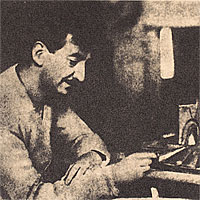Avant-garde painter and scenographer Georgi Yakulov lived most of his life in Moscow, but did not lose his connections to Armenian culture.
He was born Gevorg Yakulian in Tiflis, Russian Empire (now Tbilisi, Georgia) on January 14, 1884, and moved to Moscow in 1893, where he studied at the Lazarian Institute (1893-1900) and then at the Moscow School of Painting, Sculpture, and Architecture (1901-1903). After finishing his studies, in 1903 he joined the Caucasian regiment of the Russian army as a volunteer and took part in the Russian-Japanese war of 1904-1905.
Some of his first works, like “Horse Race” (1905) and “Roosters” (1907) were showed in Moscow exhibitions. In 1908, he became a scenographer for the Summer Theater of Moscow. In 1908 and then in 1911-1912 he visited Italy, France and Germany, met the great artists of the time, and studied the history of art. He summarized his theoretical conclusions in the essay “Blue Sun” (1914). From 1911-1921, he participated regularly in the exhibitions of the Mir Iskusstva (World of Art) association.
In his paintings, Yakulov combined Eastern and Western cultural traditions. His theory of the connection of light and line, the movement in colors, and the origin of styles was widely used in theaters. His stage design for the plays “Exchange” (Paul Claudel, 1918) and “Princess Brambilla” (E.T.A. Hoffmann, 1920), and the opera-bouffe “Giroflé-Girofla” (Charles Lecocq, 1922) were highly appreciated in Paris. He took the opposite view to that of the artists of Mir Iskusstva and defined new principles, highlighting the need for combining architectural decorations and fine arts in stage deign, seeing it as part of the constructivist style. A romantic spirit and a pathetic, monumental style are typical of his designs.
In 1914, Yakulov, along with Alexander Miasnikian (future First Secretary of the Communist Party in Armenia) and Alexey Jivelegov, a Moscow-based Armenian historian, repudiated the acts of vandalism against Armenian culture. In 1917, he showcased five paintings in the exhibition organized by the Union of Armenian Artists in Tiflis.
Yakulov was one of the founders of the Moscow Armenian Dramatic Studio, becoming head of the department of stage design. He designed the mise-en-scene of such performances as Hagop Baronian’s “Honorable Beggars” (1924) and Gabriel Sundukian’s “Pepo” (1925). Together with poets Sergei Esenin, Anatoly Marienhof, and Vadim Shershenevich, in 1918 Yakulov wrote and signed the first manifest of the imaginists, a literary group that sought to distance itself from the futurists but broke up in 1925. He designed the staging of William Shakespeare’s “The Merchant of Venice” (1926) and Alexander Shirvanzade’s “Morgan’s In-Laws” (1927) at the First Theatre of Yerevan (now Sundukian Theatre), as well as Sergei Prokofiev’s ballet “The Steel Step” (1927), commissioned by Sergei Diaghilev for Les Ballets Russes.
The artist passed away in Moscow on December 28, 1928, and was buried in the Novodevich cemetery. He had posthumous exhibitions in Yerevan (1959, 1967, 1975, 1984) and Moscow (1975). Many of his paintings remained in France and did not return to the Soviet Union until the 1970s. His works are mainly in the Armenian National Gallery in Yerevan, as well as in some Russian galleries.

